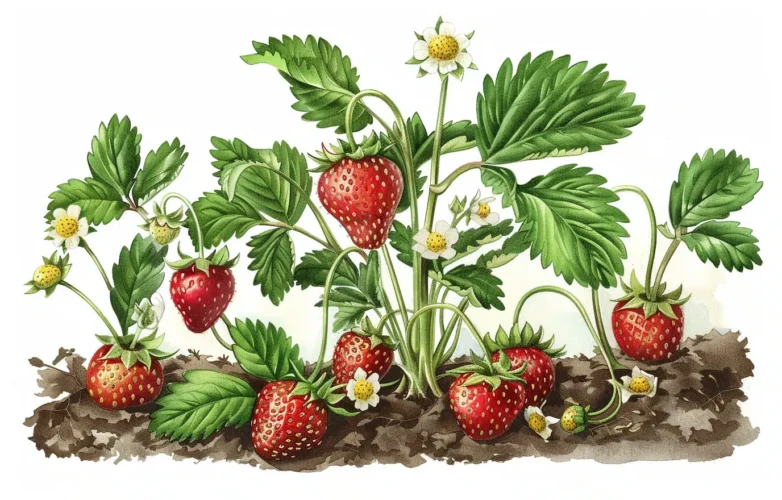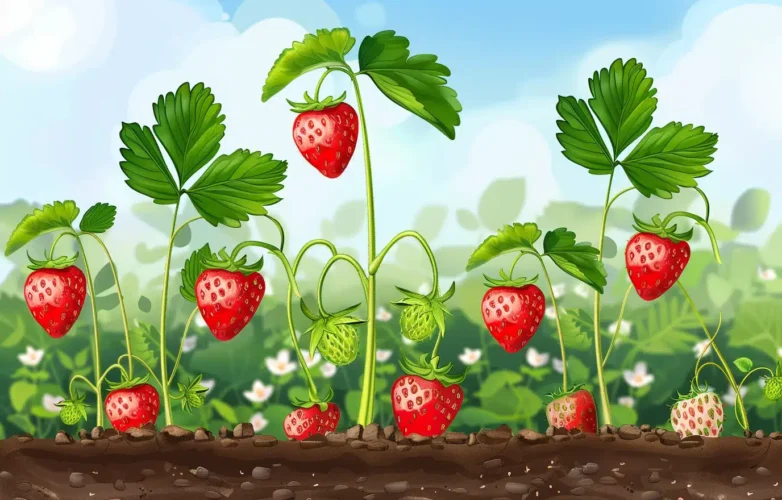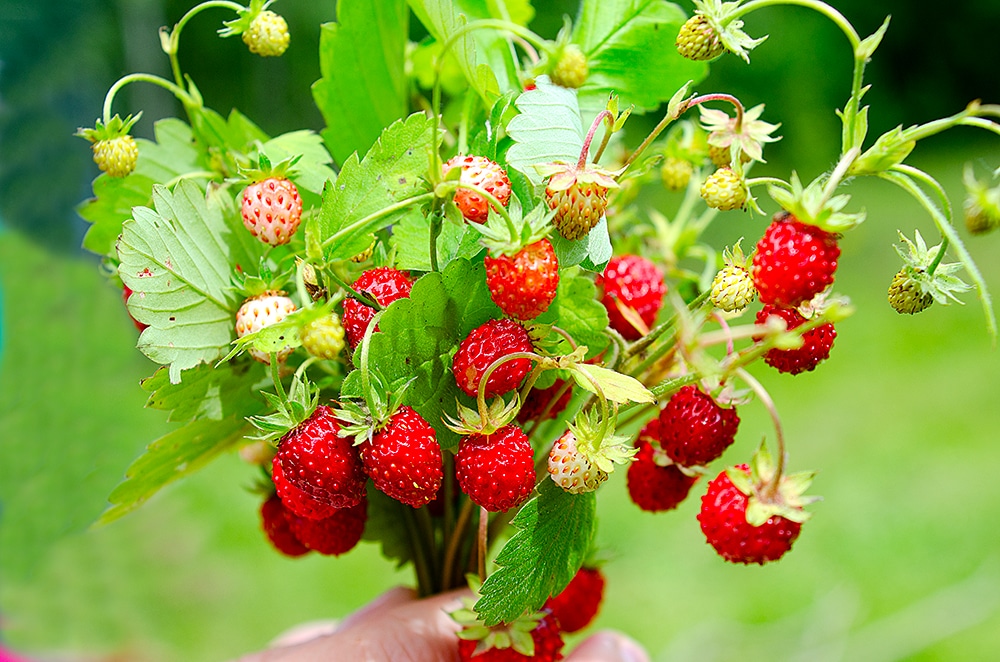
Long before gardeners cultivated strawberries into the big, juicy berries that we see in the grocery store, people across the world enjoyed harvests of wild alpine strawberries (species: fragaria vesca). Wild strawberry plants produce small berries with a lovely floral flavor. Although you may not find wild strawberries in your grocery store, they still remain a seasonal delicacy in parts of Europe today. Unlike modern cultivars, wild strawberry plants produce small crops of tiny aromatic strawberries all throughout the summer months. They also tolerate more shade than commercial strawberry varieties--making them a popular choice for edible groundcover, garden edging, containers, and urban gardens.
Alpine strawberries are some of our favorite plants to grow on our homestead. They are easy to start from seeds and can be planted in and around shady wooded areas--places where most perennial fruits fail to thrive. Although harvests are small, each berry is packed with flavor and adds a gourmet flavor to everything from baked goods to oatmeal. In this guide, we'll teach you the basics of growing alpine strawberries as well as some advanced techniques for growing wild strawberries as ground cover, in containers, and tips on how to grow bigger alpine strawberries. Enjoy!
Snapshot: Growing Alpine Strawberries
About:
Fragaria vesca. Commonly referred to as alpine strawberry, woodland strawberry, wild strawberry. Day neutral. Perennial in USDA Zones 5-9.
When to Plant:
Start seeds indoors 4 months before the last spring frost. Transplants should be sowed in early spring (Northern climates) when the ground is workable or in the fall (Southern climates).
How to Plant:
When seedlings reach 2-3" tall, transplant outdoors. Keep soil line just below the plant's crown.
Plant Spacing:
Plants can be spaced 6"-18" inches apart in rows or as many as 4-6 plants per square foot in containers. More space = bigger plants.
Germination:
Wild strawberry seeds germinate within 1-5 weeks of sowing (depending on the variety).
Best Soil:
Nutrient rich, well-draining, slightly acidic soil (pH 6-6.5) with soil temperatures between 60-75°F.
Watering:
Alpine strawberry plants need 1 inch of water per week (up to 2 inches per week while fruiting).
Sunlight:
Alpine strawberries can grow in partially shaded locations, but prefer more sunlight.
Fertilizer:
Optional if strawberries were planted in amended soil. Side dress alpine berry beds with compost, aged manure, or blood meal.
Harvesting:
Harvest strawberries when ripe and very deep red for maximum flavor.
Alpine Strawberry Basics: Know Before You Grow
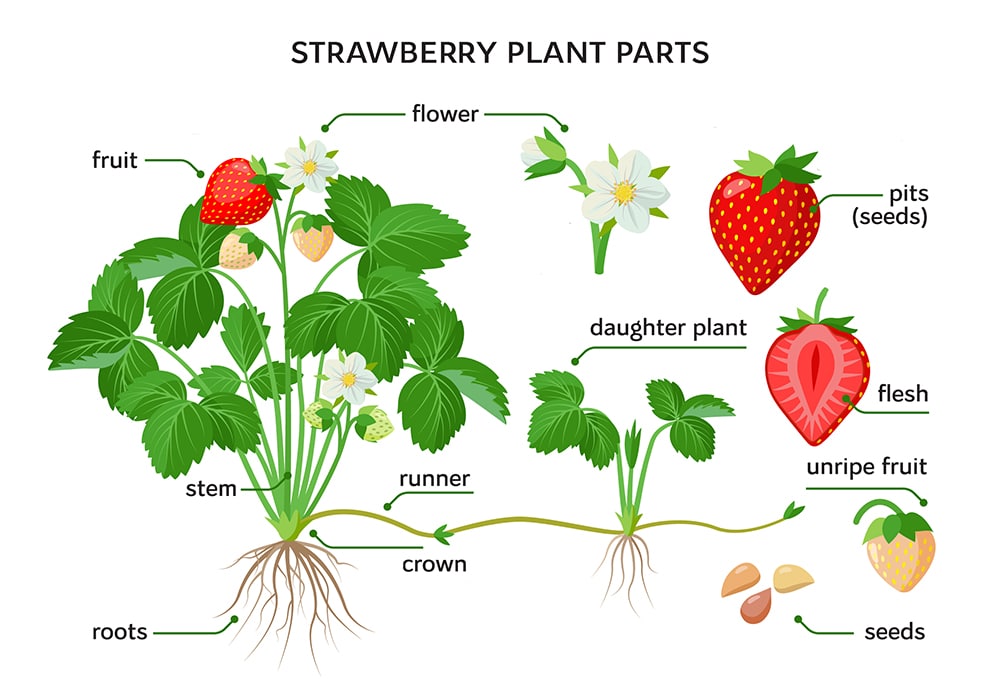
A quick search online and you'll see many blogs making distinctions of wild vs alpine strawberries. For the purposes of this article, we are discussing fragaria vesca: a popular species of day-neutral strawberry interchangeably referred to as alpine strawberries, woodland strawberries, and wild strawberries. This includes hybrid, cultivated, and heirloom varieties of alpine strawberries. Here are some fast facts to know before growing alpine strawberries:
Alpine Strawberries Are Perennial:
Alpine and wild strawberries are perennial plants that can continue to produce berries for over five years. However, berry production begins to decline dramatically after the third year and it is recommended that gardeners replace wild strawberry plants every 3 years.
Alpine Strawberries Are Day Neutral:
Alpine strawberries are a variety of day-neutral strawberries and will continuously produce fruit throughout the growing season as long as the temperatures remain between 35-85°F.
Small Berries, Small Harvests:
Wild strawberries plants produce tiny (about 1/4" in diameter) berries sporadically throughout the growing season. When it comes to quantity, I've seen wild strawberry plants produce between 1-20 edible strawberries each month depending on the variety and quality of care.
Alpine Strawberry Taste:
There are many varieties of alpine strawberries with different flavor profiles ranging from classic sweet to pineapple tart. When allowed to fully ripen, alpine strawberries have a concentrated aromatic berry flavor but lack the overt sweetness of traditional strawberries.
Can Tolerate Shade:
One of the biggest points of difference between alpine strawberries and commercial cultivars comes down to sunlight requirements. Alpine strawberries can tolerate a good amount of shade while still delivering a bounty of berries. For this reason, many gardeners grow alpine strawberries in shaded groves and patches where most fruit would grow poorly.
Getting Started: Strawberry Seeds vs Plants
Alpine strawberries can be successfully grown from seeds or nursery starts. If you're looking to grow a few plants in a small container garden, it may be easiest to purchase a few wild strawberry plants from a nursery in the spring and transplant them into pots. However, if you're looking to grow alpine strawberries as edible landscaping or in any large quantity, then starting your plants from seeds makes economical sense. Unlike commercial cultivars, wild strawberries can be reliably started from seed. As long as you aren't intimidated by words like "cold stratification" (the process of exposing seeds to a period of cold temperatures before sowing), growing strawberries from seed can be a very rewarding process.
How to Grow Alpine Strawberries from Seed

There are two options for starting alpine strawberry seeds: starting indoors or direct-sowing outdoors. While direct sow (i.e. planting the seeds directly in the garden in early spring) is the easiest method, the plants may not mature and produce a crop of berries in the initial season. If you'd like to guarantee a first-season crop from your alpine strawberry seeds--it's best to start them early indoors as follows:
Start Early:
In addition to a 30 day cold stratification period, wild strawberry seeds also need up to 5 weeks to germinate and 6-8 weeks of growth before transplanting outdoors. Thus, we recommend starting your seeds indoors 4 months before the last frost. Note: Some alpine varieties recommend direct sowing in early spring. Check your seed packet for more details.
Cold Stratification:
Strawberries must have a period of cold before they can germinate. Cold stratification is the process of exposing seeds to a cool, moist environment. This process mimics the fall, winter, spring cycle that these perennial seeds need to germinate. Place seed packet (or place loose seeds in an envelope) in an airtight bag and again into an airtight jar. The extra layers will protect the seeds from excess moisture. Keep this jar in the refrigerator for about one month. When ready to sow, allow the jar to return to room temperature before planting.
Sow Shallowly & Wait:
Strawberry seeds will germinate faster when sown shallowly and given lots of light. Prepare a seed tray with lightweight seed starting mix. Gently press a strawberry seed into each cell and cover very shallowly. Water lightly and keep moist and in a sunny location until germination within 1-5 weeks.
Transplant the Strongest Seedlings
As seedlings emerge and begin to grow, identify your strongest plants and pot them up from cell packs into a 2-4" container or biodegradable pot. Harden off once seedlings are 2-3" tall (and the last spring frost has passed) and transplant outdoors according to the planting instructions below.
- Sun Gro: Black Gold Organic Seedling Starter Mix: A light, fluffy, organic seedling starting mix that allows seedlings to get the light they need to germinate.
- Seed Starter Tray with Humidity Dome: An all-in-one seed starting set complete with humidity dome for early germinating.
- Seedling Starting Heat Mat: Germinate your strawberry seeds fast by keeping their soil at the perfect temperature with a easy-to-use heat mat.
- Indoor LED Grow Lights: Strawberry seeds need light for germination. These easy-to-install indoor LED grow lights can be used to ensure successful germination in any lighting environment.
Transplanting Wild Strawberry Plants
Follow these instructions whether you've started your strawberries from seed or purchased young plants from a nursery. Starting in early spring, when the ground is workable, wild strawberry plants can be transplanted into raised garden beds, containers, and gardens. Here are some tips on transplanting strawberry plants:
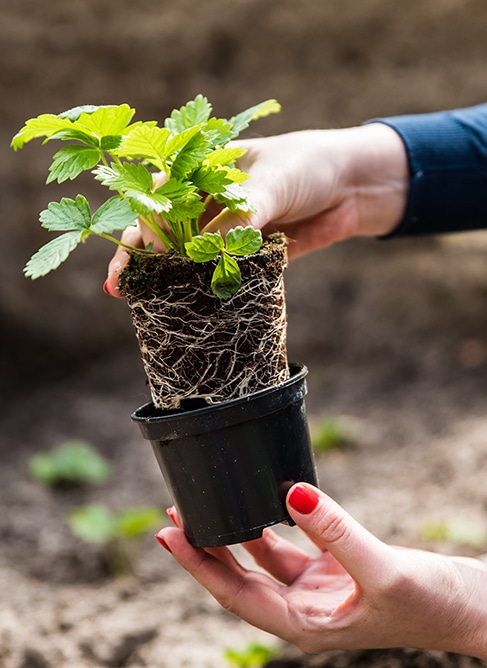
Amend Your Soil:
Strawberries plants of all varieties benefit from nutrient-rich, slightly acidic, fluffy soil. Prepare your strawberry bed by adding amendments like compost, aged manure, worm compost tea, or a nitrogen-rich berry blend.
Dig a Wide Hole
Dig a hole large enough to accommodate the entire root system of your strawberry plant without burying the crown. Place the root ball into the hole and use both hands to firmly backfill more soil around the plant. Water plants thoroughly.
Protect the Crown:
Plant your strawberries so that the crown rests at or just above the soil line. The crown is the fleshy bulb that sits just above the root system. This is where new growth emerges from and plants will die if the crown is covered. Examine your plant and plant your transplants into the ground at the same soil level as their previous container.
Water Thoroughly:
Make sure that your strawberry plants receive a thorough watering after transplanting. Often, water can pool on top of freshly packed soil. Moisten the soil with a little water and allow it to absorb before adding more. Alternatively, you can prime the soil by watering the planting hole and soil before backfilling.
How Long Does it Take for Alpine Strawberries to Grow?
Alpine strawberry seeds are slow to germinate and can take as long as 1-5 weeks after sowing to sprout (refer to your seed packet for a variety specific timeline). Once germinated, wild strawberry seedlings will continue to grow for a few weeks until they reach a height of 2-3" tall. At that time, the plants are ready to be hardened off and transplanted outdoors--typically in early spring. Within the first week of spring planting, strawberry plants will produce new roots and leaves. By early summer, strawberry plants will have developed runners and blossoms. Approximately one month after blossoming, strawberries reach maturity and fruit can be harvested. Once temperatures begin to cool, strawberry plants descend into dormancy and lose their leaves. Plants will remain dormant until the following spring.
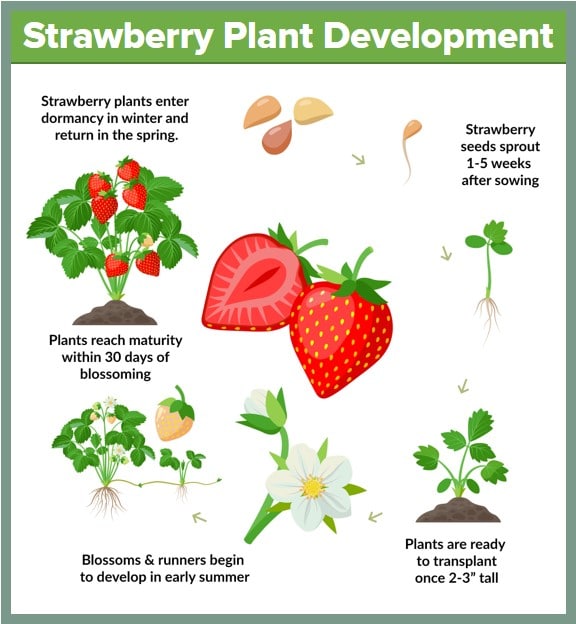
Alpine Strawberry Plant Spacing
Wild strawberry plants can be spaced anywhere from 6"-18" inches depending on your gardening goals. When it comes to spacing, the general rule to remember is this: more space = bigger, more productive plants. For groundcover and edging, where your goal is to create a thick patch of low-lying plants, space strawberries closer together. If you want to maximize berry size and yield, then give each plant more space. As a guideline, 12-18" inches is a good range for larger plants and 6"-8" inches is best for groundcover. We encourage home gardeners experiment with different spacings and see for themselves how it effects plants in their specific environment.
Alpine Strawberry Runners & Spacing:
Runners are vine-like stems that emerge from the mother plant and will propagate into new strawberry plants if allowed to take root. Some alpine strawberry plants produce runners and some do not. Matted Row system spaces strawberry plants far apart and allows the runners to propagate and fill the gaps. At first, your strawberry patch will look bare, the runners will quickly take over and create an interwoven (or "matted") patch. Because this system relies heavily on runners, it is best suited for Junebearing strawberry varieties; although, it can be done in smaller space with everbearing varieties as well. The most common spacing recommendation for a matted row is 3ft wide planting rows spaced 3-4ft apart, with plants spaced 18-24" inches within each row.
The Hill System spaces strawberries closer together and removes all runners. By removing the runners, each individual strawberry plant grows larger/taller--resembling a "hill." Contrary to popular belief, the "hill" system has nothing to do with planting strawberries in a hill of soil (although, this is a helpful strategy for better drainage in low-lying areas). The most commonly recommended spacing for hill system strawberry patches is 1-3ft rows, spaced 14 inches apart, with plants spaced 10-12 inches apart within the rows.
Container Spacing:
Up to six wild strawberry plants can be grown per square foot; however, I've found the sweet spot to be somewhere around 3-4 plants per square foot. See the section below on growing alpine strawberries in containers for more details.
Alpine Strawberries As Ground Cover & Edible Landscaping
Wild strawberries make great edible ground cover for landscapes and garden beds. When planting strawberries for ground cover, look for a variety that boasts runners, vigorous growth, and a bounty of beautiful berries such as fragaria virginiana (or Virginia Strawberry). Because you'll be prioritizing density over fruit production, wild strawberries grown as groundcover can be spaced as close as 6"-10" inches apart.
Growing Alpine Strawberries in Containers
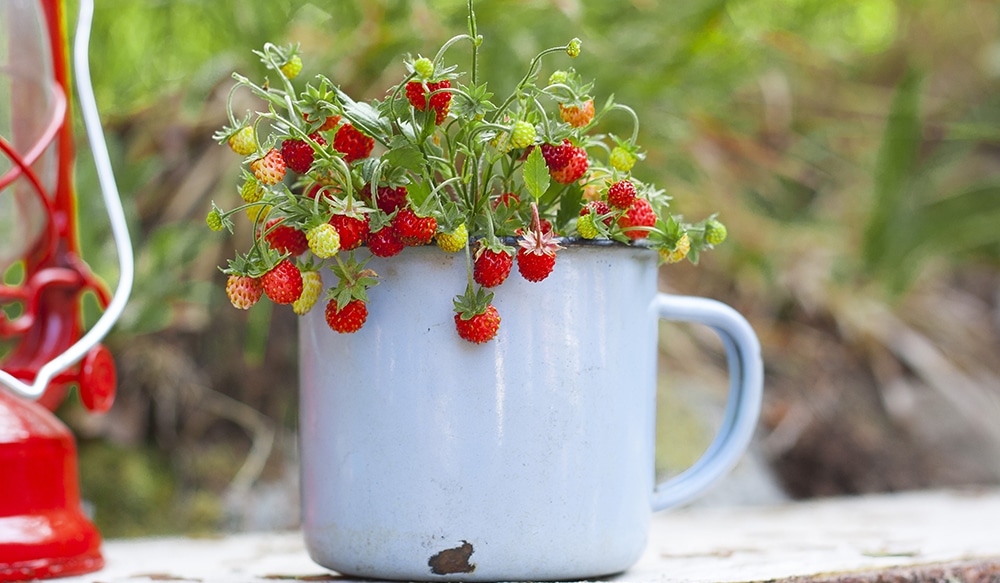
Wild strawberries grow abundantly in containers and there is no sweeter treat than a fresh French mignonette strawberry grown on a sunny windowsill. You don't need any special container (although, there are some specialty containers for strawberries that are fun), but good drainage and at least some sunlight are musts. In addition to many of the tips in this article, here's some specific advice on how to get large harvests from alpine strawberries grown in containers:
Choose the Sunniest Location:
Even though wild strawberries can tolerate a good deal of shade, it is still in the gardeners best interest to give their plants as much sunlight as possible. Now, "as much sunlight as possible" may only mean 3-4 hours of sunlight per day indoors, but it's still better than no sunlight. If you're really ambitious, you can move your strawberry plants throughout the day to ensure that they are also getting the most sun possible. Again, not necessary, but it will increase your harvest size.
Use Rich Potting Soil:
Strawberries are heavy feeders, but they don't enjoy frequent fertilization during the growing season. The best way to feed your container strawberries at the start with a nutrient-dense, well-draining, potting soil amended with compost.
Spacing:
Container strawberries can be spaced 6-8 inches apart (3 plants per sqft). Keep in mind: the more space you give each plant, the bigger the berries the plant will produce.
Mulch & Water Often:
Ideally, you'd want to mulch your container strawberries to help retain moisture. The smaller your strawberry container, the more frequently you may have to water your plants (monitor the soil for dryness or use an automatic plant waterer).
Alpine Strawberry Plant Care & Maintenance:
Once your strawberries are planted in their final home, it's easy to care for them on an ongoing basis. At the very minimum, wild strawberries need some sun and water to produce their fruit. If you want to maximize yields, you can also take on the task of fertilizing your wild strawberries. If you really want to grow the biggest berries, read our section below on Advanced Alpine Strawberry Growing Tips.
Watering:
Strawberries need about 1" inch of water per week. This is a general guideline and depends greatly on your plant's specific location, container, soil type, etc. What we like to do is test the soil for dryness every few days or so with an index finger. Strawberries have shallow roots which penetrate about 6" below the soil. If the top 2-3 inches of soil feels dry when you dig in with your finger, give your plants a water. If it feels moist or wet, wait a few days and test again.
Fertilizing:
Care should be taken not to overfertilize strawberry plants. If your strawberries were planted in nutritious soil to begin with, they may not need to be fertilized. Skip the fertilizer if your plants are growing well, appear strong, and have dark green vegetative growth. Otherwise, you can side-dress your plants with compost, aged manure, or berry food shortly after the final harvest of the year in preparation for next season.
True Organic
Berry Food Fertilizer
Happy soil makes happy strawberry plants! Grow big, juicy, bright red strawberries with this organic strawberry fertilizer made with everything berries love.
Advanced Alpine Strawberry Growing Tips
Want to learn how to grow bigger, juicier, sweeter wild strawberries? This section is for anyone who wants to go the extra mile and invest more time and energy into their alpine strawberry patch for bigger harvests and berries. These are the techniques that we employ for our own wild strawberries which have consistently produced delicious results--enjoy!
Mulching Alpine Strawberries
All strawberry varieties benefit from heavy mulching. Mulching helps to retain moisture, keep weeds at bay, prevent fungal diseases, prevent fruit spoilage, and protects strawberries from frost during the winter months. Pine needles are our favorite type of mulch for strawberry plants. Pine needles provide good frost protection and help to acidify the soil for acid-loving strawberries. For low maintenance mulching, simply plant your wild strawberries near the canopy of a pine tree and let the needles naturally mulch your berries as they drop in the fall.
Growing Bigger Alpine Strawberries

By pinching off the blossoms of newly planted wild strawberry transplants, you force the plant to focus its precious energy on root and foliage development. With bigger roots and leaves, the plant is now able to gather more nutrients from the soil and create bigger strawberries.
This strategy is fine if you have a few strawberry plants, but can be tedious when tending to large wild strawberry patches. If you want bigger berries, but don't want to spend all day pinching strawberry blossoms, then simply pinch off blossoms on occasion throughout the first year of plant growth. Even pinching off a few blossoms here and there will help new strawberry transplants establish stronger root systems.
Weeding the Wild Strawberry Patch
Generally speaking, strawberries are poor competitors for weeds and their production can be easily diminished when grown in a bed alongside weeds. However, I've found wild strawberries to be more resilient against weeds than their commercial counterparts. With that said, strawberry plants grow best in a weed-free environment.
Harvesting, Storing, & Preserving Alpine Strawberries
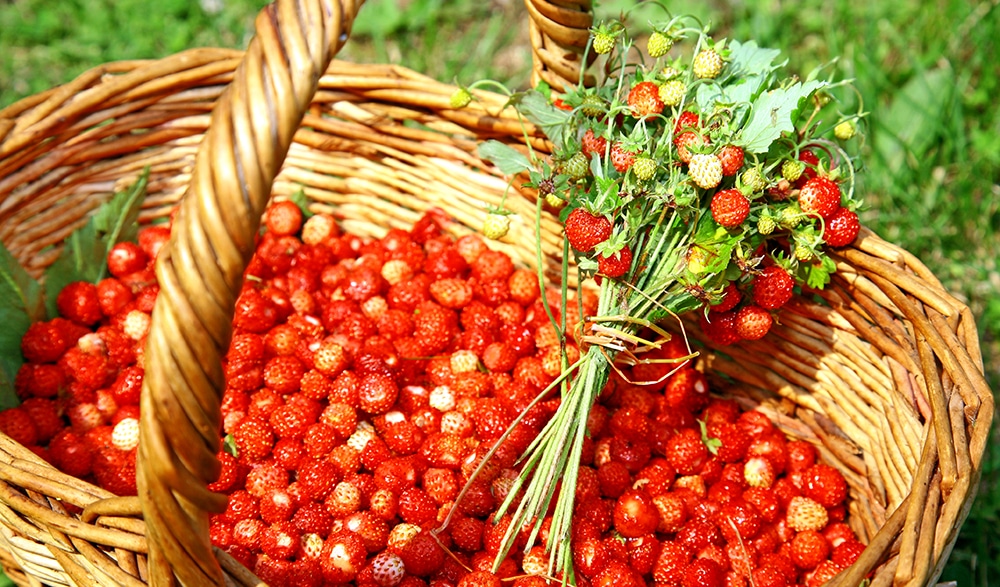
When it comes to harvesting wild strawberries, much more patience is required on the part of the gardener than commercial Everbearing and Junebearing strawberry varieties. This is because you absolutely must for wild strawberries to turn a deep red hue before harvesting. Luckily, alpine berries have almost no desirable flavor at all until fully ripened. So, there won't be too much temptation to harvest early. Once the fruit are fully ripened, they can be harvested in the same way as larger strawberries: gently grab the stem just above the berry crown and give it a twist to break the stem. You can also use a small pair of pruning clippers to quickly cut the berries away where the stem meets the fruit. Picking strawberries from the stem (instead of pulling on the berries themselves) prevents you from squishing the soft berries between the force of your fingers.
Wild strawberry plants aren't known for their bumper crop harvests. The berries are small and the harvests and small--which make these berries quite the delicacy. Wild strawberries can be enjoyed fresh, frozen, dehydrated, and freeze-dried just like traditional strawberries. The most common recipes you'll find for wild strawberries include wild strawberry jams, muffins, tarts, and other desserts.
Strawberry Growing & Maintenance Calendar
Wild strawberries are perennial plants which have a four season life cycle. With proper care, your wild strawberry plants can produce quality crops for about 3 years before needing to be replaced. Here is a simple yearly maintenance calendar that explains how to care for your strawberry plants each season. This timeline is an approximation based on a typical four-season environment. Adjustments should be made for those in very cold or hot growing zones.
January - February
New Strawberries: Research strawberry varieties, prepare your garden bed, purchase your strawberry seeds or potted transplants.
Strawberry Seeds: Begin cold stratification by placing your seeds in the refrigerator for a minimum of 30 days before germinating. Sow seeds according to germinating instructions.
Existing Strawberry Bed: Continue to protect plants with heavy mulch during the winter months.
March - April
Transplant New Strawberry Plants: Transplant your strawberries into the prepared garden as soon as the soil is workable. If necessary, protect new plants from lingering heavy frosts with row covers.
Transplant Strawberry Seedlings: Once strawberry seedlings are 2-3" tall, harden off and transplant into the garden.
Uncover Existing Strawberry Beds: Gently brush off mulch to expose strawberry plants to the spring sunlight. Do not remove the surrounding mulch.
May
New Strawberries: Monitor plants for runners and blossoms. Remove runners for Hill System. Train and propagate runners for Matted Row. Pinch off any blossoms that appear from now until the end of June.
Existing Strawberry Beds: Remove runners for Hill System. Train and propagate runners for Matted Row.
June - July - August
New Strawberries: Continue pinching blossoms. Apply fertilizer after summer blossoming has finished.
Existing Strawberries: Harvest summer fruit from strawberries.
September - October
All Strawberries: Harvest final late summer strawberries. Once temperatures consistently reach below 40°F, cover plants in 4-6 inches of mulch. Continue watering as normal and make adjustments as necessary for precipitation/snowfall.
November - December
All Strawberries: All strawberries should remain covered in heavy mulch throughout the winter months when hard frosts are possible.
Alpine Strawberry Diseases, Pests, & Troubleshooting

Wild strawberries are susceptible to the same varieties of diseases as commercial strawberry cultivars. Prevention is the best strategy for combating strawberry fungal diseases. The best advice for prevention is to protect your strawberries by keeping plants well-mulched to prevent fruit from contacting the soil, keep your strawberry patch clear of any dead leaves or fruit from, and water your strawberry plants from below to keep excess moisture off of the plant. Here's a brief primer on common strawberry fungal diseases and how to spot them.
Strawberry Leaf Rot:
Strawberry leaf rot is a common disease caused by the fungus phomopsis obscurans which overwinters on dead plant debris (source). Here's how to spot it in your garden:
- Circular leaf lesions with dark center and red outer ring.
- Brown spots on fruit resembling leaf spots.
Solution: No known cure. Remove diseased parts of the plant (or the entire plant for severe infections) to stop the spread.
Strawberry Fruit Rot:
Strawberry fruit rot is a common disease also known as botrytis rot, fruit blight, and gray mold. Here's how to spot it in your garden:
- Some or entire parts of the plant are covered in a grey, velvety, fuzzy mold.
- Green and ripe berries begin to rot on the plant.
Solution: No known cure. Remove diseased parts of the plant (or the entire plant for severe infections) to stop the spread.
Strawberry Root Rot:
Strawberry root rot is a soil-borne strawberry disease also known as red stele. Caused by a fungi that is most prevalent in cooler climates and poorly-drained wet soils. Here's how to spot it in your garden:
- Reddish, brown leaves appearing in the second year.
- Plant wilt and plant death in the first season.
- Poor plant growth: small berries and few runners.
Solution: No cure. Fungus can remain in the infected soil for years. Destroy infected plants. Either choose a new planting location, select a red stele resistant variety, or both.
Verticillium Wilt:
Another soil-borne fungal disease which is best dealt with via prevention. Here's how to spot it in your garden:
- Leaves begin to wilt.
- Leaves change color from green to brown and fall off the plant.
Solution: No cure. Destroy infected plants and surrounding soil. Do not plant strawberries alongside or in beds following nightshades (tomatoes, eggplant, potatoes, peppers) or roses which are also susceptible to verticillium wilt. Plant disease resistant varieties including Surecrop, Catskill, and Allstar.
Alpine Strawberry Pests
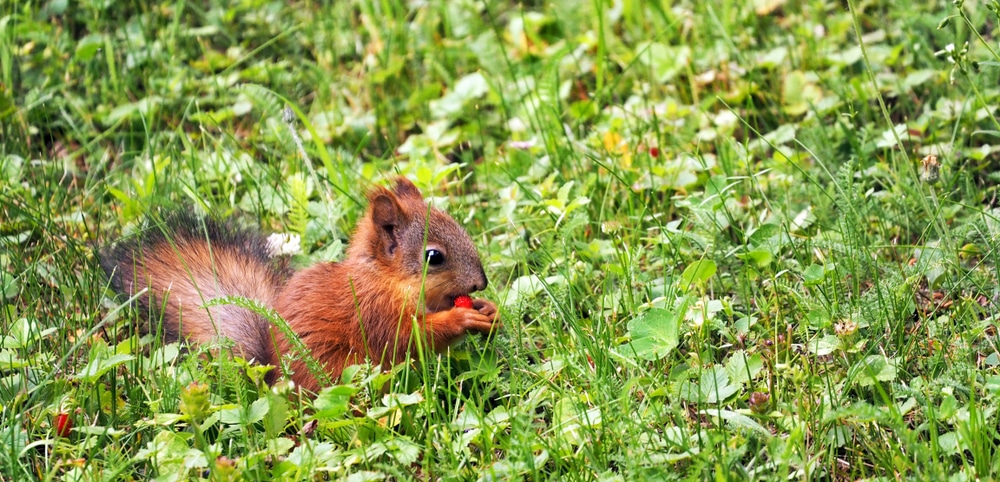
Theoretically, alpine strawberries are vulnerable to the same pests as other strawberry varieties. Personally, in my garden, I've never had an issue with squirrels, birds, or deer going after my wild strawberries. At least, not nearly as much of a problem as with my larger Everbearing patch. With that said, if you are struggling to keep pests out of your alpine strawberry plants, then here are some simple tips and tricks to deal with them:
| Pest | Problem | Solution |
|---|---|---|
| Strawberry Bud Weevil | Small insects which damage blossom buds and leaves. | Remove infested flower buds. Manually remove adults. Beneficial nematodes may prevent larval root damage. Dust infected areas with sulfur. |
| Strawberry Seed Weevil | Small beetle that eats seeds from outside of strawberry. | Pest is attracted by weeds. Weed patch often. Remove weevils at night by hand. |
| Strawberry Crown Borer | Beetle which lays eggs in strawberry crowns causing plant death. | No treatment. Plants due without apparent cause. Move strawberry patch to a new location. |
| Grubs | Larvae of June bugs eat strawberry roots. | Examine roots of dead plant for evidence of grubs. Beneficial nematodes help control grub infestations. |
| Strawberry Leaf Roller | Small insects that feed on the underside of leaves. | Examine plants frequently for upward curled leaves. Remove and burn all infected leaves. |
| Slugs | Pests that eat the flesh of fruit at night. | Avoid wet soils. Apply diatomaceous earth 3" around plant base. Try a beer trap. |
| Birds | Animals eat and damage ripening strawberry fruit. | Use floating row covers or fruit cages. Try painted decoy rocks while plants are blossoming. |
Buying Alpine Strawberry Plants & Seeds
Ready to start your wild strawberry garden? Alpine strawberries are available in a variety of colors (yellow strawberries, white strawberries, and traditional red strawberries) and shapes. You can purchase either wild strawberry plants or wild strawberry seeds to start your garden.
- Mignonette Alpine Strawberries: Seeds | small red berries | container friendly | ornamental & edible
- Pineapple Alpine Strawberries: Heirloom Seeds | 1" yellow berries | container friendly | ornamental & edible.
- Alexandria Alpine Strawberries: Seeds | small red berries | container friendly | very productive.
- Red Wonder Wild Strawberries: Seeds | small red berries | container friendly | ornamental & edible.
- Fragaria Virginiana Wild Strawberry: Plants | small red berries | ground-hugging| great for ground cover.
- Woodland Strawberry: Plants | small red berries | container friendly | ground cover
Frequently Asked Questions About Growing Strawberries
Do Alpine Strawberries Fruit the First Year?
Alpine strawberries can produce strawberries during their first year (usually in late summer).




